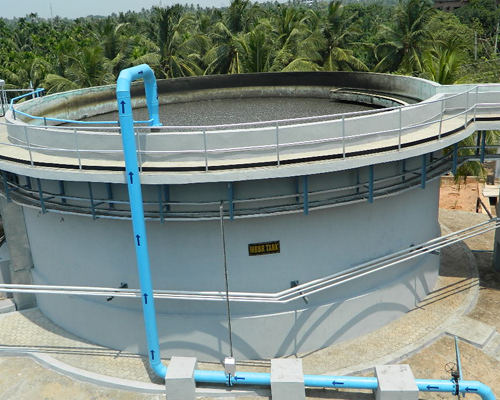BIOLOGICAL TREATMENT

The stabilisation of wastewater is accomplished biologically using a variety of microorganisms. The microorganism converts colloidal and dissolved organic matter into various gases and simpler molecules which can be further removed by gravity settling.
- Anaerobic Treatment :
Anaerobic Treatment is an energy-efficient process in which bacteria transforms organic waste in the wastewater into biogas in the absence of oxygen. To achieve this oxygen-free environment, the entry of air into anaerobic tanks is prevented, typically by a gastight cover. - Upflow Anaerobic Sludge Blanket (UASB) :
Upflow Anaerobic Sludge Blanket (UASB) technology, also known as UASB reactor is a form of an anaerobic digester that is used for wastewater treatment. In this process, wastewater flows upward through the blanket of sludge and microorganism degrade the organic matter and produces methane gas as a by-product, which further can be used as fuel. - Aerobic Treatment :
Aerobic is the process in which microorganisms convert organics waste into carbon dioxide and new biomass in the presence of oxygen. Aerobic treatment requires continuous oxygen supply so forced air from air blowers is mixed with the wastewater, where the aerobic bacteria feed on the waste in the water. - Activated Sludge Process (ASP) :
In the ASP process, microorganism thoroughly mixed with organic compounds contained in wastewater under such conditions that stimulate their growth. As the microorganisms grow and are mixed by the agitation of the air, the individual organisms flocculate to form an active mass of microbes called activated sludge that derives the name of the process as ‘Activated Sludge Process’.
In a conventional activated sludge process, the wastewater is typically aerated for six to eight hours in a long, rectangular aeration basins. Sufficient air is provided to keep the sludge in suspension. The air is injected from the bottom through a system of diffusers. - Sequential Batch Reactor (SBR) :
SBR is an application of ASP that is operated on a batch basis. It is used in small communities where space is limited. The design principles for this reactor are keyed to the following treatment steps:
Fill: During this phase, the basin receives influent wastewater
React: During this phase aeration and mixing units are on
Settle: Air and mixing are turned off. The activated sludge is allowed to settle - Moving Bed Biofilm Reactor (MBBR) :
MBBR is an economical and efficient solution for wastewater treatment. MBBR system consists of an aeration tank containing special plastic elements called media, to support the growth of biofilm in the reactor. These media have a large surface area for optimal contact with water, air and bacteria. The bacteria grow on the surface of the media and break down the organic matter from the wastewater. It significantly increases the capacity and efficiency of the existing plant and decreases the carbon footprint. - Membrane Bioreactor (MBR) :
MBR is used in biological treatment with membrane separation. Membrane Bioreactor consists of a biological reactor with suspended biomass and solids separation by Microfiltration(MF) or Ultrafiltration(UF) membranes.

